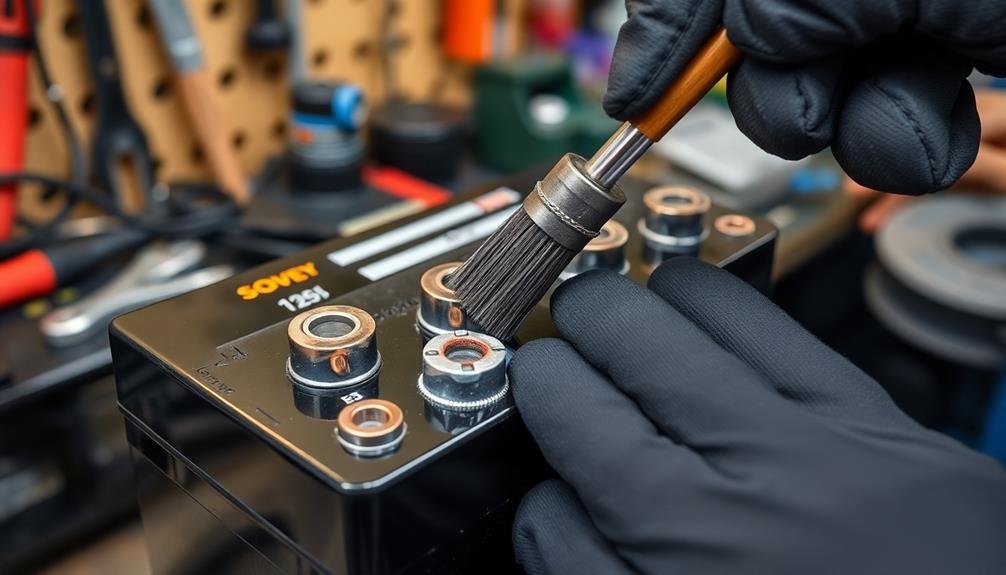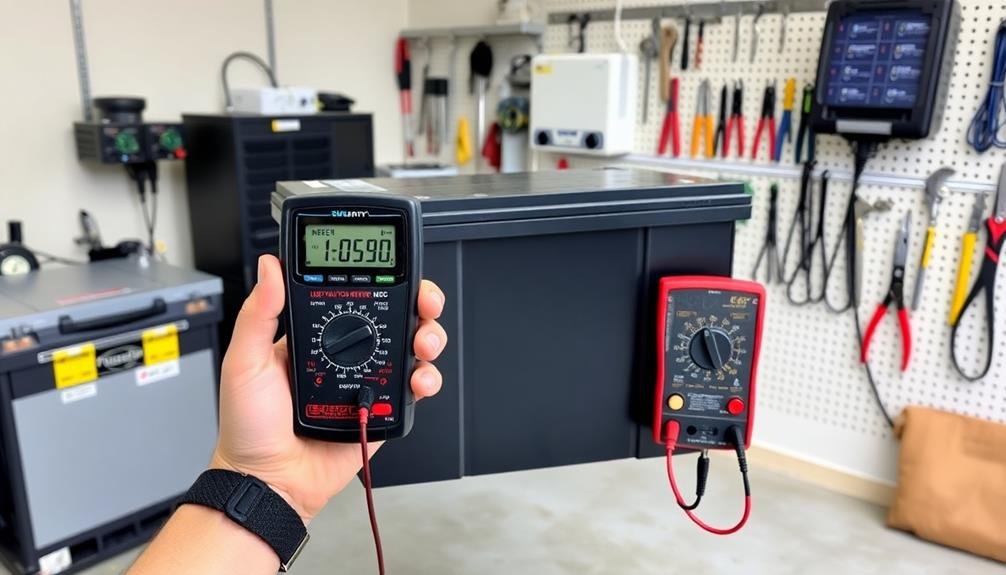To maximize your home battery's lifespan, focus on three key maintenance practices. First, maintain regular charge cycles, keeping the state of charge between 20% and 80% to reduce stress on the cells. Second, control the temperature by installing your battery in a climate-controlled area and using cooling systems when necessary. Third, clean the connections regularly, removing corrosion and applying protectant. You should power down the system before cleaning and use a wire brush for stubborn buildup. By following these practices, you'll considerably extend your battery's life and improve its performance. Discover more in-depth tips to further optimize your home energy storage system.
Regular Charge Cycles

For ideal performance and longevity, it's crucial to maintain regular charge cycles for your home battery system. Establish a consistent schedule to charge and discharge your batteries, preventing them from sitting idle for extended periods.
Aim to keep your battery's state of charge between 20% and 80% most of the time, as this range helps maximize its lifespan.
Don't let your batteries fully discharge too often, as this can lead to capacity loss over time. Instead, try to recharge them before they drop below 20%.
Similarly, avoid keeping them at 100% charge for long periods, as this can cause unnecessary stress on the cells.
During peak energy production times, such as sunny days for solar systems, verify your batteries are ready to accept a full charge.
In the evenings or during high-demand periods, use the stored energy to power your home. This regular cycling helps maintain battery health and efficiency.
If you're going away for an extended period, set your system to maintain a partial charge, around 50%, to prevent degradation.
Temperature Control
While often overlooked, temperature control plays an essential role in maintaining your home battery system's health and performance. Extreme temperatures can greatly impact your battery's lifespan and efficiency. To guarantee ideal functioning, you'll need to monitor and regulate the temperature of your battery's environment.
Here are four key practices for effective temperature control:
- Install your battery in a climate-controlled area: Choose a location that's not exposed to direct sunlight or extreme temperature fluctuations.
- Use insulation: If your battery is in an unheated space, consider adding insulation to protect it from cold temperatures.
- Implement a cooling system: For hot climates, install fans or air conditioning to prevent overheating.
- Monitor temperature regularly: Use a thermometer or built-in temperature sensors to keep track of your battery's environment.
Clean Connections

Temperature control is just one aspect of home battery maintenance. Equally important is keeping your battery connections clean. Over time, corrosion and dirt can build up on the terminals, reducing efficiency and potentially causing damage.
To clean your battery connections, first verify the system is powered down. Disconnect the terminals, starting with the negative cable. Inspect for signs of corrosion, which often appears as a white, green, or bluish substance. Use a wire brush to gently remove any buildup. For stubborn corrosion, apply a mixture of baking soda and water, then scrub.
After cleaning, dry the terminals thoroughly with a clean cloth. Apply a thin layer of petroleum jelly or terminal protector spray to prevent future corrosion. Reconnect the cables, making sure they're tight but not over-tightened.
You should clean your battery connections at least twice a year, or more frequently if you live in a humid climate. Regular cleaning helps maintain ideal conductivity, guarantees proper charging, and extends your battery's lifespan.
It's a simple task that can greatly impact your home battery system's performance and longevity.
Frequently Asked Questions
How Often Should I Replace My Home Battery System?
You should replace your home battery system every 10-15 years, depending on usage and maintenance. However, you'll want to monitor its performance regularly. If you notice significant capacity loss or efficiency decline, consider replacing it sooner.
Can I Use My Home Battery During a Power Outage?
Yes, you can use your home battery during a power outage. It's designed to provide backup power when the grid fails. You'll have electricity for essential appliances and devices, keeping your home running smoothly until power is restored.
What Safety Precautions Should I Take When Handling Home Batteries?
When handling home batteries, you'll need to wear protective gear like gloves and goggles. Don't touch exposed terminals, keep batteries away from water, and guarantee proper ventilation. Always follow manufacturer's guidelines and avoid short-circuiting the battery.
Are There Any Specific Brands of Home Batteries Recommended for Longevity?
You'll find that Tesla Powerwall, LG Chem RESU, and Sonnen eco are highly recommended for longevity. They're known for their durability and performance. However, don't forget that proper maintenance is essential regardless of the brand you choose.
How Do I Dispose of an Old or Damaged Home Battery Safely?
You should never dispose of home batteries in regular trash. Contact your local recycling center or hazardous waste facility for proper disposal. They'll often accept old batteries for free. Some retailers also offer battery recycling programs you can use.
In Summary
You've now learned the three key practices for maintaining your home battery system. By implementing regular charge cycles, controlling temperature, and keeping connections clean, you'll greatly extend your battery's lifespan. Remember, consistency is essential. Make these habits part of your routine maintenance schedule, and you'll enjoy reliable power storage for years to come. Don't neglect your investment – a little care goes a long way in preserving your home battery's performance and longevity.





Leave a Reply